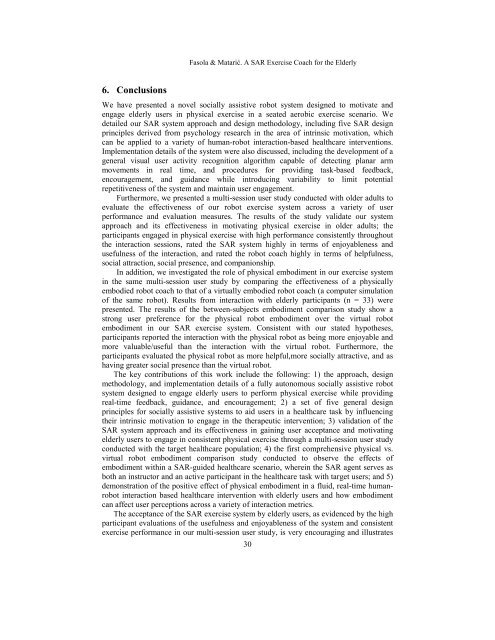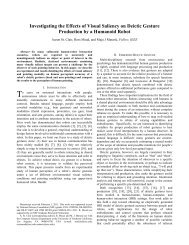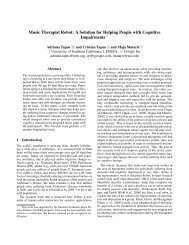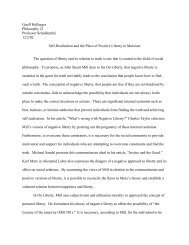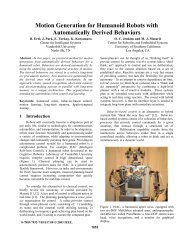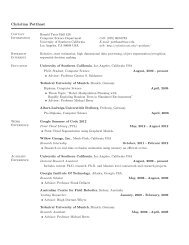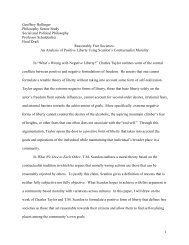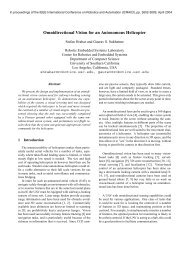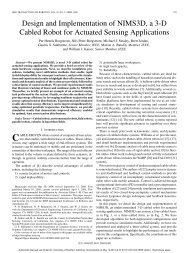A Socially Assistive Robot Exercise Coach for the Elderly
A Socially Assistive Robot Exercise Coach for the Elderly
A Socially Assistive Robot Exercise Coach for the Elderly
Create successful ePaper yourself
Turn your PDF publications into a flip-book with our unique Google optimized e-Paper software.
Fasola & Matarić. A SAR <strong>Exercise</strong> <strong>Coach</strong> <strong>for</strong> <strong>the</strong> <strong>Elderly</strong>6. ConclusionsWe have presented a novel socially assistive robot system designed to motivate andengage elderly users in physical exercise in a seated aerobic exercise scenario. Wedetailed our SAR system approach and design methodology, including five SAR designprinciples derived from psychology research in <strong>the</strong> area of intrinsic motivation, whichcan be applied to a variety of human-robot interaction-based healthcare interventions.Implementation details of <strong>the</strong> system were also discussed, including <strong>the</strong> development of ageneral visual user activity recognition algorithm capable of detecting planar armmovements in real time, and procedures <strong>for</strong> providing task-based feedback,encouragement, and guidance while introducing variability to limit potentialrepetitiveness of <strong>the</strong> system and maintain user engagement.Fur<strong>the</strong>rmore, we presented a multi-session user study conducted with older adults toevaluate <strong>the</strong> effectiveness of our robot exercise system across a variety of userper<strong>for</strong>mance and evaluation measures. The results of <strong>the</strong> study validate our systemapproach and its effectiveness in motivating physical exercise in older adults; <strong>the</strong>participants engaged in physical exercise with high per<strong>for</strong>mance consistently throughout<strong>the</strong> interaction sessions, rated <strong>the</strong> SAR system highly in terms of enjoyableness andusefulness of <strong>the</strong> interaction, and rated <strong>the</strong> robot coach highly in terms of helpfulness,social attraction, social presence, and companionship.In addition, we investigated <strong>the</strong> role of physical embodiment in our exercise systemin <strong>the</strong> same multi-session user study by comparing <strong>the</strong> effectiveness of a physicallyembodied robot coach to that of a virtually embodied robot coach (a computer simulationof <strong>the</strong> same robot). Results from interaction with elderly participants (n = 33) werepresented. The results of <strong>the</strong> between-subjects embodiment comparison study show astrong user preference <strong>for</strong> <strong>the</strong> physical robot embodiment over <strong>the</strong> virtual robotembodiment in our SAR exercise system. Consistent with our stated hypo<strong>the</strong>ses,participants reported <strong>the</strong> interaction with <strong>the</strong> physical robot as being more enjoyable andmore valuable/useful than <strong>the</strong> interaction with <strong>the</strong> virtual robot. Fur<strong>the</strong>rmore, <strong>the</strong>participants evaluated <strong>the</strong> physical robot as more helpful,more socially attractive, and ashaving greater social presence than <strong>the</strong> virtual robot.The key contributions of this work include <strong>the</strong> following: 1) <strong>the</strong> approach, designmethodology, and implementation details of a fully autonomous socially assistive robotsystem designed to engage elderly users to per<strong>for</strong>m physical exercise while providingreal-time feedback, guidance, and encouragement; 2) a set of five general designprinciples <strong>for</strong> socially assistive systems to aid users in a healthcare task by influencing<strong>the</strong>ir intrinsic motivation to engage in <strong>the</strong> <strong>the</strong>rapeutic intervention; 3) validation of <strong>the</strong>SAR system approach and its effectiveness in gaining user acceptance and motivatingelderly users to engage in consistent physical exercise through a multi-session user studyconducted with <strong>the</strong> target healthcare population; 4) <strong>the</strong> first comprehensive physical vs.virtual robot embodiment comparison study conducted to observe <strong>the</strong> effects ofembodiment within a SAR-guided healthcare scenario, wherein <strong>the</strong> SAR agent serves asboth an instructor and an active participant in <strong>the</strong> healthcare task with target users; and 5)demonstration of <strong>the</strong> positive effect of physical embodiment in a fluid, real-time humanrobotinteraction based healthcare intervention with elderly users and how embodimentcan affect user perceptions across a variety of interaction metrics.The acceptance of <strong>the</strong> SAR exercise system by elderly users, as evidenced by <strong>the</strong> highparticipant evaluations of <strong>the</strong> usefulness and enjoyableness of <strong>the</strong> system and consistentexercise per<strong>for</strong>mance in our multi-session user study, is very encouraging and illustrates30


